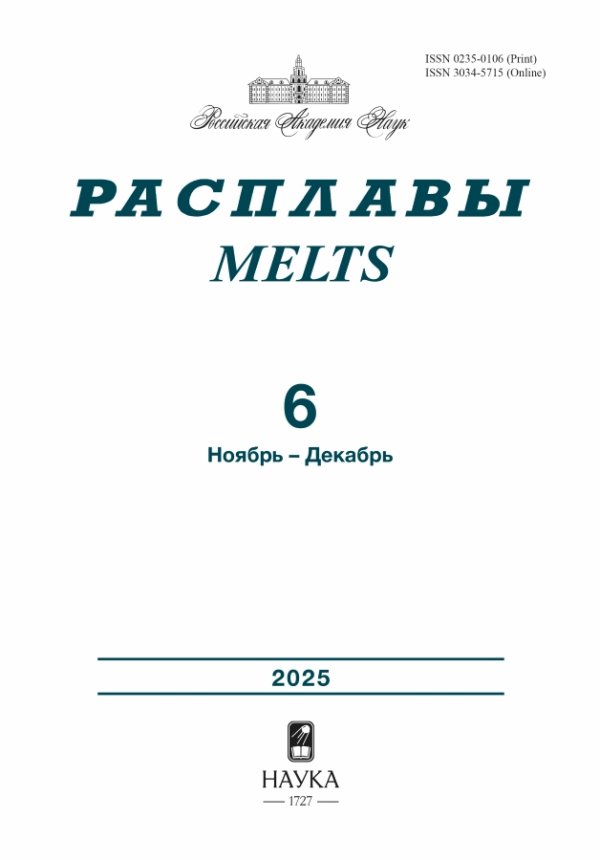№ 1 (2023)
- Год: 2023
- Выпуск опубликован: 01.01.2023
- Статей: 12
- URL: https://journals.rcsi.science/0235-0106/issue/view/7984
Весь выпуск
Статьи
Первый всероссийский семинар “Электрохимия в распределенной и атомной энергетике”
 3-4
3-4


Электрохимическое поведение скандия в расплаве LiF–CaF2–ScF3
Аннотация
Электрохимическое поведение скандия в галогенидных расплавах представляет интерес как с точки зрения разработки новых электрохимических способов получения скандия и материалов на его основе, так и с точки зрения имитации электрохимического поведения продуктов деления при пирохимической переработке отработавшего ядерного топлива в расплавленных солях. Методами циклической вольтамперометрии, квадратно-волновой вольтамперометрии и хронопотенциометрии изучены закономерности электровосстановления ионов скандия в зависимости от параметров электролиза расплава LiF–CaF2–ScF3 при температуре 800°С. Показано, что электровосстановление скандия в исследуемом расплаве происходит при потенциалах отрицательнее –0.45 В относительно потенциала алюминиевого электрода, при этом электроосаждение скандия на электроде способствует электровосстановлению катионов лития с деполяризацией. При анализе полученных поляризационных зависимостей отмечено, что процесс электровосстановления скандия протекает в одну 3-х электродную стадию, при этом не является электрохимически обратимым. Сделано предположение, что причиной необратимости является стадия образования новой фазы. В результате электрохимических измерений сделан вывод, что благодаря широкому “электрохимическому окну” расплав LiF–CaF2 может быть использован для электрохимического синтеза скандия и для изучения закономерностей совместного или селективного электровосстановления минорных актинидов и лантаноидов.
 5-13
5-13


Увеличение стеклообразующей способности сплава Co41Fe7Cr15Mo14C15B6 при разбавлении редкоземельными металлами
Аннотация
Эвтектические сплавы из-за своей низкоплавкости являются перспективными материалами для получения металлических стекол. В отличие от кристаллических сплавов, в стеклах отсутствует дальний порядок, что приводит к повышению твердости, механической прочности, коррозионной стойкости и магнитной проницаемости. Возможности использования данных материалов на практике регламентируются критическим диаметром, при котором еще возможно образование однофазного металлического стекла при закалке. Поэтому актуальной задачей в этой области исследований является повышение критического диаметра имеющихся аморфных сплавов. Одним из методов улучшения стеклообразующей способности сплавов является их разбавление более тугоплавкими металлами. В данной работе представлены рентгеноаморфные металлические стекла сплавов (Co41Fe7Cr15Mo14C15B6)100 – xRx с разбавлением редкоземельными металлами (R = Gd, Ho, La, Nd, Y, Yb; x = 0; 2). Методами рентгеновской дифракции и сканирующей электронной микроскопии установлен критический диаметр, фазовый и элементный состав сплавов в зависимости от скорости закалки. Установлено, что добавление 2 ат. % Gd, Ho и Y значительно увеличивает стеклообразующую способность сплава Co–Fe–Cr–Mo–C–B. Методом спиннингования, при закалке на алюминиевом диске, вращающемся с линейной скоростью 11.5 м/с, получены ленты толщиной от 19 до 73 мкм. На поверхности лент были обнаружены редкие включения с высоким содержанием редкоземельных элементов вплоть до 35 ат. %, которые могут выступать в качестве центров кристаллизации.
 14-21
14-21


Анализ структурных единиц и их стабильности в расплаве Na2О–B2O3 методом первопринципной молекулярной динамики
Аннотация
Целью настоящей работы являлась разработка расчетно-теоретической методики детального изучения геометрии и статистических характеристик локальных структурных комплексов сложных жидкостей типа щелочноборатных систем, имеющих тенденцию к образованию объемной борокислородной сетки. Методика отрабатывалась на примере расплава 30Na2O–70B2O3 при Т = 1273 К. Использовалась первопринципная молекулярная динамика, реализованная в программном коде VASP для суперячейки из 250 атомов. Полученные на каждом шаге координаты ионов использованы для получения статистически значимой информации о детальной структуре расплава. По разработанной для этой цели оригинальной программе были определены парциальные функции радиального распределения атомов и проанализированы все найденные в модели ближайшие координации вокруг каждого сорта ионов, определены типы и количество устойчивых группировок, длины связей и углы в них. Кроме того, рассчитан критерий тетраэдричности для единиц ВО4 и ВB4. Базовыми структурными единицами оказались почти правильные треугольники (в них входит ~80% атомов бора) и тетраэдры (~19% атомов бора) с ионом бора в центре и ионами кислорода в вершинах. Эти простые структуры образуют борокислородную сетку связанную общими (мостиковыми) атомами кислорода, причем она включает практически все атомы бора. Обнаружены надструктурные единицы, а именно комбинации из трех и более базовых структур. Например, два треугольника и один тетраэдр, образуют кольца из шести чередующихся атомов бора и кислорода. Кроме того, обнаружено существование колец, которые сформированы из четырех базовых структурных единиц, но они, в отличие от шестиатомных колец, не являются планарными образованиями. Предложенная методика позволяет получать практически любые данные о структурных особенностях систем такого типа, в частности, ответить на важный вопрос о количестве мостиковых и немостиковых атомов кислорода. Оказалось, что мостиковых кислородов в изученной системе примерно 86%. Использованный подход корректно учитывает ковалентную и ионную связи в жидких системах на основе оксидов-сеткообразователей и оксидов-модификаторов, что позволит изучить изменение локальных структурных характеристик в зависимости от концентрации и температуры и объяснить поведение различных физико-химических свойств.
 22-38
22-38


Высокотемпературное пассивирование поверхности кандидатных материалов для ЖСР посредством добавления О2– в солевую фазу галогенидного расплава
Аннотация
Были проведены эксперименты по определению скорости коррозии нержавеющей стали AISI 316 во фторидных расплавах с различной концентрацией O2– (путем добавления в расплав оксида лития в диапазоне концентраций от 0 до 5 мас. %). В результате серии экспериментов установлено, что происходит снижение скорости коррозии на порядок при концентрации анионов кислорода в расплаве от 0.2 до 0.4 мас. %, что может свидетельствовать об обнаружении явления высокотемпературной пассивации материала за счет модифицирования состава фторидного расплава и снижения его коррозионной активности. Кроме того, типичный для нержавеющих сталей тип межкристаллитной и питтинговой коррозии во фторидных расплавах, наиболее опасной с точки зрения конструкционного реакторного материала, при добавлении оксида лития изменяется на сплошной за счет “залечивания” отдельных коррозионных очагов избыточными кислородсодержащими соединениями. Установлено образование защитного слоя шпинельного типа толщиной 1 мкм.
 39-47
39-47


О механизме образования интерметаллидов при совместном катодном восстановлении ионов в расплавленных солях
Аннотация
В настоящее время известны два механизма электролитического синтеза интерметаллидов (ИМ) при одновременном восстановлении (co-reduction) их ионов на катоде в солевых расплавах. И оба они являются ошибочными. Один из них противоречит экспериментальным данным и нарушает законы термодинамики. Другой не представляет собой процесс совместного восстановления, так как на катоде должны одновременно восстанавливаться ионы обоих металлов, а не одного из них. Работа не содержит новых экспериментальных данных, она носит чисто теоретический характер. Предложен и термодинамически обоснован механизм co-reduction процесса. Впервые показано, что первые кристаллы ИМ возникают не на поверхности электроположительного металла, а они кристаллизуются на поверхности бинарного гомогенного твердого раствора, состоящего из компонентов ИМ, который образуется в начальный момент электролиза. Показано и термодинамически подтверждено, что ионы электроотрицательного металла восстанавливаются с деполяризацией. Впервые приведены электрохимические уравнения кристаллизации фазы постоянного состава при длительном электролизе, а также электрохимические уравнения кристаллизации других фаз интерметаллидов на поверхности предыдущих. Впервые объяснено наличие нескольких фаз ИМ в катодном осадке, полученном при длительном электролизе в гальваностатических условиях. Рассмотрен механизм электрокристаллизации ИМ для случаев гальваностатического и потенциостатического режимов электролиза, а также для циклической и прямоугольной вольтамперометрии. Он применим также к co-reduction процессу кристаллизации соединений металлов с неметаллами.
 48-58
48-58


Устойчивость MgO в эвтектических расплавах Li2CO3–Na2CO3 и Li2CO3–K2CO3
Аннотация
Научно-технические разработки в области топливных элементов на расплавленных карбонатах (MCFC) в последнее время ориентированы на улучшение их характеристик в режиме преобразования парниковых газов для хранения химической энергии. Изменение состава газа, питающего MCFC, требует поиска новых устойчивых составов загустителя. В представленной работе проведены коррозионные испытания магнезиальной керамики в эвтектических карбонатных расплавах Li2CO3–Na2CO3 и Li2CO3–K2CO3 при 600°С в течение 270 ч. Подтверждено, что оксид магния MgO проявляет низкую растворимость в расплавах карбонатных солей щелочных металлов и высокую химическую устойчивость. Выводы о стабильности материала основаны на результатах элементного анализа расплавов, результатах рентгенофазового анализа и сканирующей электронной микроскопии. Магнезиальная керамика может быть рекомендована в качестве загустителя расплавленного электролита в химических накопителях энергии, работающих на воздухе в качестве преобразователей парникового газа.
 59-67
59-67


Емкость и импеданс иридиевого электрода в расплавленных хлоридах щелочных металлов
Аннотация
Методом спектроскопии электрохимического импеданса исследованы закономерности поведения емкости иридиевого электрода в зависимости от основных физико-химических параметров: электрического потенциала, температуры, радиуса катиона щелочного металла. Также проведена проверка влияния частоты сигнала, использующегося в переменнотоковых электрохимических методах исследования, на величину емкости и форму емкостной кривой. Данные по емкости иридиевого электрода получены в расплавленных хлоридах натрия, калия и цезия в диапазоне температур 1093–1123 K и диапазоне частоты переменного сигнала 3 · 100–3 · 104 Гц во всей доступной области электрической поляризации. Полученные емкостные кривые имеют два основных минимума с максимумом между ними. Один из этих минимумов (катодный) идентифицирован как классический потенциал минимума емкости. Уменьшение частоты сигнала и температуры эксперимента, а также увеличение радиуса катиона в ряду NaCl–KCl–CsCl приводит к появлению одного или двух дополнительных минимумов в области потенциалов между основными минимумами. Глубина этих промежуточных минимумов возрастает с ростом радиуса катиона щелочного металла солевого электролита, а их потенциал при этом смещается в положительную сторону. Расчетные значения емкости двойного электрического слоя и адсорбционной емкости были получены методом эквивалентных электрических схем. Один из дополнительных минимумов, полученных при прямом измерении зависимости емкости электрода от потенциала на высокой частоте, воспроизводится при расчете емкости двойного слоя. Второй из дополнительных минимумов, полученных на низкой частоте, воспроизводится при расчете адсорбционной емкости.
 68-77
68-77


Поверхностное натяжение и плотность расплавов индий–олово и их зависимость от состава и температуры
Аннотация
В работе представлены результаты измерения поверхностного натяжения (σ) и плотности (ρ) расплавов индий–олово. Измерения σ и ρ проведены разными методами. Поверхностное натяжение измерено методом лежащей капли и максимального давления в капле, а плотность – ареометром и методами лежащей капли. Для исследований использованы металлы высокой чистоты In-00, олово – ОВЧ. Максимальная ошибка измерения σ равна 0.8%, а ρ – 0.2%. Зависимость σ расплавов In–Sn от состава характеризуется экстремумом (пологим минимумом) в области эквимолярного состава. С ростом температуры глубина минимума уменьшается, его положение смещается в сторону чистого индия. Молярные объемы имеют небольшие положительные отклонения от аддитивных значений. С увеличением температуры молярные объемы приближаются к аддитивным величинам. Методом лежащей капли были измерены температурные зависимости σ и ρ разбавленных по индию растворов In–Sn. Показано, что добавки индия понижают поверхностное натяжения олова. С учетом того, что значение поверхностного натяжения индия выше, чем у олова, такой результат свидетельствует о том, что изотермы поверхностного натяжения системы индий-олово должны пройти через минимум.
 78-88
78-88


Плотность и электропроводность расплавленных солевых смесей фторида бериллия с хлоридами щелочных металлов
Аннотация
Сведения о плотности и электропроводности солевых расплавов представляют интерес как для оценки возможности их использования для электролитического получения и рафинирования бериллия и других технологических процессов, так и анализа возможного взаимодействия компонентов. Данные о плотности расплавленных солевых систем, содержащих фторид бериллия и хлориды щелочных металлов, получены методом гидростатического взвешивания. Шар-поплавок и нить подвеса были выполнены из платины. В качестве материала тигля и чехла термопары использовали окись бериллия. В системах BeF2–MeCl (Me = Li, Na, K, Cs) и BeF2–(Li–K)эвт–Cl исследовано от 9 до 14 расплавленных солевых смесей, содержащих от 0 до 100% фторида бериллия, при повышении температуры на 100–200 К от температуры плавления смеси со средним шагом 10 К. В связи с особенностями поведения индивидуального фторида бериллия при нагревании выше температуры плавления (высокая вязкость и интенсивное испарение) плотность расплавленной соли измеряли методом максимального давления в газовом пузырьке. Одновременно с плотностью капиллярным методом была измерена электропроводность этих расплавов. Материал измерительной ячейки – окись бериллия, измерительные электроды – платиновые стержни диаметром 1 мм. Постоянную ячейки определяли и регулярно контролировали по расплаву высокочистого хлорида калия. Все операции по подготовке солевых смесей, отбору проб для химического анализа и измерение свойств проводили в изолированной атмосфере сухого и дополнительно очищенного аргона. Результаты измерений представлены на графиках и в форме полиномов первого и второго порядка, отражающих зависимость плотности и электропроводности от температуры для различных составов солевых смесей. Значения одновременно измеренных величин плотности и электропроводности использовали для расчета молярного объема и молярной электропроводности электролитов. Изотермы молярного объема имеют практически линейный характер, что указывает на слабое взаимодействие компонентов расплава. Изотермы молярной электропроводности имеют характерный перегиб в области составов, содержащих около 30 мол. % фторида бериллия, что может быть связано с образованием комплексных соединений в жидкой фазе.
 89-98
89-98


Краткий обзор результатов использования электроосажденного кремния для устройств преобразования и накопления энергии
Аннотация
Благодаря своей распространенности в природе и свойствам, кремний является одним из самых востребованных материалов в различных отраслях промышленности. В настоящее время металлургический кремний получают карботермическим восстановление кварца, который затем подвергают гидрохлорированию и многократному хлорированию для получения солнечного кремния. В данном кратком обзоре представлен анализ альтернативных методов получения кремния электролизом расплавленных солей. Рассмотрены факторы, определяющие выбор состава расплавленных солей, типичные осадки кремния, полученные электролизом. Выполнена оценка результатов и перспектив дальнейшего использования электроосажденного кремния в литий-ионных источниках тока и репрезентативные результаты испытаний по использованию электролитического кремния в устройствах преобразования солнечной энергии. Отмечены задачи, которые необходимо решить для практической реализации методов электролитического производства образцов кремния, пригодных для новых устройств и материалов преобразования и накопления энергии.
 99-108
99-108


Филатову Евгению Сергеевичу – 75 лет
 109-110
109-110











